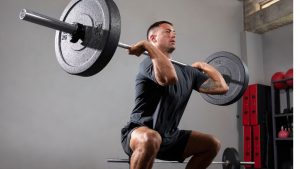Here’s why front squats can test your grip strength:

Positioning of the Barbell
In a front squat, your hands are positioned in a “clean grip” or “crossed-arm grip.” The barbell rests across the front of your shoulders while your fingers support it, often making it a bit more challenging to maintain a secure hold. As you progress through the squat movement, especially when lifting heavier weights, the grip on the bar becomes crucial in keeping the barbell stable.
Core Engagement
Front squats demand significant core engagement to maintain an upright torso position. As your core works hard to stabilize your body, your grip strength plays a vital role in supporting the barbell’s weight and preventing it from slipping forward.
Fatigue Factor
As you perform multiple reps of front squats, your grip strength can weaken due to fatigue. This can make it more challenging to maintain a solid grip on the barbell, adding an extra layer of difficulty to the exercise.

Grip-Specific Variations
Some variations of front squats, like the Zercher squat, place even more emphasis on grip strength. In the Zercher squat, the barbell is held in the crooks of your elbows, intensifying the demand on your grip.
Tips: enhance your grip strength for front squats
To enhance your grip strength for front squats or any other exercises that require a strong grip, consider incorporating specific grip-strengthening exercises into your routine. Movements like farmer’s walks, dead hangs, wrist curls, and using grip trainers can help improve your overall grip strength, making it easier to handle heavier weights during front squats.
Remember, if you’re new to front squats or increasing the weight significantly, your grip strength may initially be a limiting factor. But with consistent practice and targeted grip-strengthening exercises, you’ll likely notice improvements over time, allowing you to comfortably tackle heavier front squats.
Diving deeper into front squats and grip strength:
Refining Technique
Perfecting your front squat technique can also alleviate some of the strain on your grip. Focus on positioning the barbell comfortably across your shoulders while maintaining a tight grip without over-squeezing the bar. Finding the right balance between grip strength and allowing the bar to rest comfortably on your shoulders can make a significant difference.
Grip Variations
Experimenting with different grip styles might help. Some lifters find success with the “clean grip,” where the barbell rests on the tips of the fingers with the elbows raised. Others prefer the “crossed-arm grip,” where the arms are crossed to create a stable platform for the barbell. Test these variations to find which one feels more secure for you.
Equipment Considerations
Certain equipment can assist in improving your grip strength during front squats. For instance, using lifting straps or chalk can provide extra grip support. Lifting straps wrap around the bar and your wrist, allowing you to rely less on your actual grip strength and more on the straps’ support. However, while helpful, relying too heavily on straps might hinder your natural grip strength development.
Gradual Progression
Gradually increasing the weight you lift during front squats will naturally challenge your grip strength. However, it’s crucial to progress sensibly. Rushing into heavier weights before your grip strength catches up can compromise your form and increase the risk of injury. Slow, steady increments in weight will allow your grip strength to develop alongside your overall strength.
Recovery and Adaptation
Like any other muscle group, your grip strength needs time to recover and adapt. Incorporate rest days into your workout routine to allow your grip muscles to heal and strengthen. Additionally, including exercises that target forearm and hand muscles can complement your grip strength development and prevent overuse injuries.
By paying attention to your grip strength, refining your technique, experimenting with variations, and giving yourself ample time for progression and recovery, you can enhance your grip strength and confidently tackle front squats while reaping their full benefits for your lower body strength and overall fitness.
Remember, it’s not just about lifting heavy; it’s about lifting safely and effectively. Strengthening your grip will not only benefit your front squats but also enhance your performance in various other exercises where a strong grip is essential.
External Links for Further Reading:
The Science Behind Grip Strength and How to Develop It
Here’s a comparative table highlighting the differences between front squats and back squats, focusing on various aspects including muscle activation, technique, and grip involvement:
| Aspect | Front Squats | Back Squats |
|---|---|---|
| Barbell Position | Across the front of shoulders | Across upper back (trapezius muscles) |
| Muscle Emphasis | Quads, core, upper back, shoulders | Quads, glutes, hamstrings, lower back |
| Grip | Requires a strong grip throughout | Grip less of a limiting factor |
| Torso Position | Upright torso position, demanding core strength | Slightly inclined torso position |
| Technique | Emphasizes maintaining an upright torso, often requires wrist flexibility | Emphasizes hip and back strength, less demand on wrist flexibility |
| Muscle Activation | Emphasis on anterior muscles (front of the body) | Emphasis on posterior muscles (back of the body) |
| Stability | Requires stability to prevent bar from rolling forward | Stability needed to maintain barbell position on upper back |
| Difficulty Level | Can be more challenging due to the front position of the barbell | Generally considered more natural and easier for beginners |
| Grip Development | Provides significant challenge to grip strength | Grip strength less challenged compared to front squats |
These differences can impact your training focus and the specific muscles targeted during each exercise. Front squats emphasize more anterior muscle engagement, such as the quads, while back squats engage more posterior muscles like the hamstrings and glutes.
Understanding these distinctions allows you to choose the variation that aligns best with your fitness goals and helps you tailor your workout routine to target specific muscle groups or address particular strength needs.
External Links for Further Reading:
Wrapping up
Front squats and back squats each offer unique benefits and challenges. While front squats specifically challenge grip strength due to the barbell’s positioning, back squats provide a different set of advantages, relying less on grip strength and emphasizing different muscle groups.
Choosing between the two often depends on your fitness goals, preferences, and individual strengths. Incorporating both into your workout routine can offer a well-rounded lower body strength training regimen while also developing various muscle groups and addressing specific weaknesses.
Remember, whether you’re aiming to enhance grip strength, target specific muscles, or refine your overall strength, consistent practice and attention to proper form are key to maximizing the benefits of both front squats and back squats.
Ultimately, it’s not about which squat variation is superior; it’s about finding the one that suits your body, aligns with your fitness objectives, and allows you to perform exercises safely and effectively.
By understanding the distinctions between these squat variations, you can make informed decisions about your workout routine and optimize your training to achieve your fitness aspirations.
So, embrace the differences, explore what works best for you, and enjoy the journey of enhancing your strength and fitness through these versatile squat variations.
Happy squatting!

Hey there, it’s Mike Rrsq, the Editor-in-Chief over at Jsquat.com, and I’m absolutely obsessed with all things squat fitness! I’ve been lucky enough to get some serious recognition for my work in this field. With a solid background in the fitness and wellness industry, I’ve been there right from the get-go, helping shape this website into what it is today.
You see, I’m not just the boss around here; I’m also a passionate contributor. I love sharing my insights through my articles, and trust me, they’re not your run-of-the-mill stuff. Each piece I write is a labor of love, filled with my expertise and real-world experience in the fitness universe. So, if you’re into fitness and looking for some inspiration, you’re in the right place!
Related Posts
- The best mix of front squats and back squats for boosting leg strength in the Clean & Jerk and Snatch
Front squats and back squats are both essential exercises for building leg strength in weightlifting,…
- Should landmine squats make me feel a challenge in my quadratus lumborum?
Landmine squats are a dynamic exercise that engages multiple muscle groups, primarily targeting the lower…
- Are Front Squats Better To Do Than Back Squats? (5 things to know- Explained)
Are front squats better than back squats? Discover the answer to this age-old question and…
- Front Squats vs. Back Squats: Which Should a 23-Year-Old Choose
At 23, the world seems like a playground, but when it comes to fitness, choices…
- Barbell front squats push or pull exercise: (Explained)
Are barbell front squats a push or a pull exercise? It's a common question that…
- Can Front Squats Be Considered Equal to Back Squats (Explained)
When it comes to building lower body strength and muscle mass, the squat is…
- The Importance of Front Squats for Male-Athlete Agility
When it comes to athletic performance, agility stands as a crucial pillar for success. For…
- The pros and cons of doing front squats only (no back squats) For 23-year-old females
Front squats offer a unique twist to your workout routine, especially when opting for them…
